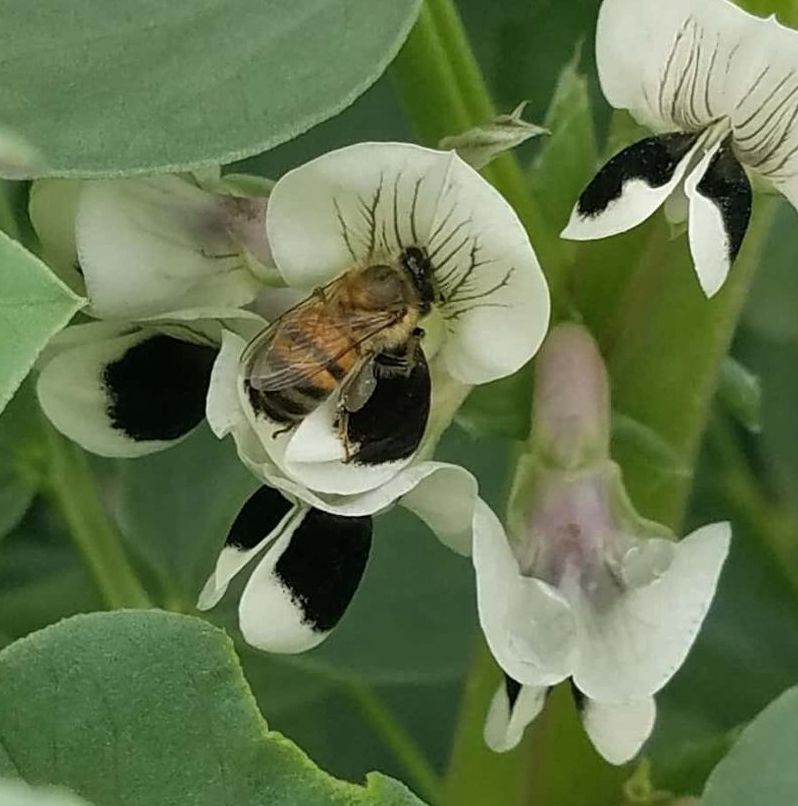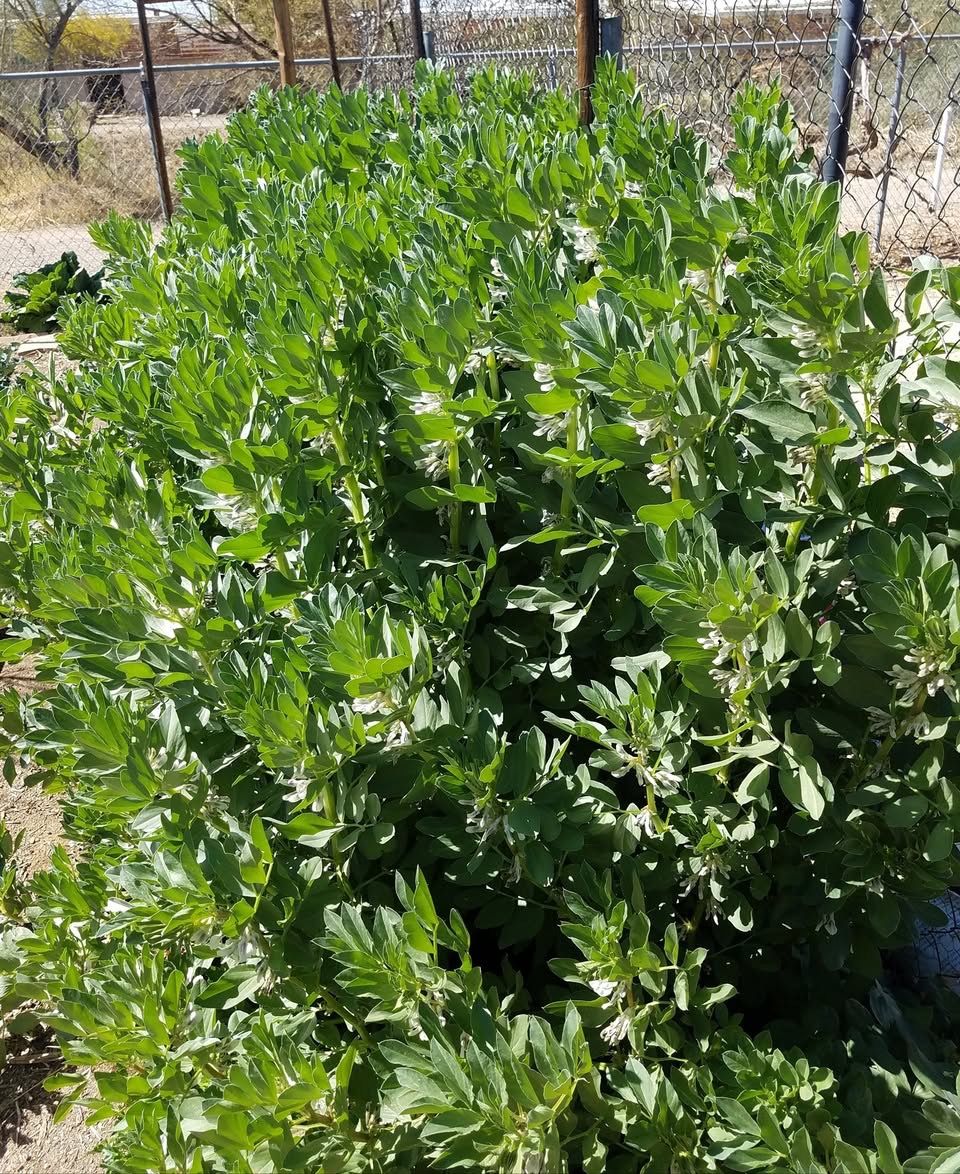BROAD BEANS aka FAVA BEANS
Growing Broad Beans from Seed: A Complete Guide
Broad beans, also known as fava beans (Vicia faba), stand apart from their warm-weather cousins in the bean family. While snap beans, lima beans, and pole beans demand summer's heat, broad beans thrive in the cool embrace of spring and fall. For gardeners seeking to extend their growing season or enrich their soil, these hardy legumes offer remarkable versatility.
Understanding the Cool Season Advantage

Unlike most beans that wilt at the first hint of frost, broad beans are remarkably cold-tolerant. They actually prefer temperatures between 60-65°F and can withstand light frosts down to about 20°F once established. This unique characteristic makes them an invaluable crop for gardeners looking to maximize their productive seasons.
The key to success lies in understanding your climate and timing your planting accordingly.
In Mild Winter Areas (USDA Zones 8-10): Fall planting is ideal in regions where winters remain relatively frost-free. Sow seeds from October through December for a spring harvest. The plants will grow slowly through the cooler months, establishing strong root systems before producing abundantly as temperatures warm in late winter and early spring. This timing also helps them complete their lifecycle before summer heat arrives, which can cause flowers to drop without setting pods.
In Cold Winter Climates (USDA Zones 3-7): Direct sow seeds in early spring, as soon as the soil can be worked—typically 4-6 weeks before your last frost date. The soil temperature should be at least 40°F. In the coldest zones, some gardeners successfully plant in late fall for early germination the following spring, though this requires well-drained soil to prevent seed rot. For these regions, spring planting is generally more reliable.
Broad Beans as a Cover Crop
Beyond their culinary value, broad beans serve an important ecological function in the garden. As members of the legume family, they form symbiotic relationships with Rhizobium bacteria in their root nodules, capturing atmospheric nitrogen and converting it into a form plants can use. When you cut down broad bean plants at soil level and leave the roots in place, or turn the entire plant into the soil, you're adding valuable nitrogen for subsequent crops.

Many gardeners plant broad beans specifically as a winter cover crop in mild climates, sowing them densely in fall and turning them under in early spring before planting summer vegetables. This practice not only enriches the soil but also improves soil structure, suppresses weeds, and prevents erosion during the rainy season.
Varieties: Large Seed vs. Small Seed Types
Broad beans come in two main categories, each with distinct characteristics:
Large-Seeded Varieties (Windsor or Longpod types): These cultivars, such as 'Windsor', 'Broad Windsor', and 'Aquadulce Claudia', produce fewer but larger beans per pod—typically 3-5 beans. The seeds themselves can be substantial, sometimes as large as a thumbnail. These varieties are generally hardier and better suited for fall planting in mild climates or early spring planting in cold regions. They're excellent for drying and have a robust, earthy flavor.
Small-Seeded Varieties: Varieties like 'Crimson Flowered' and many heirloom types produce more numerous, smaller beans per pod—often 6-8 beans. These tend to be sweeter and more tender when harvested young. They're prized for eating fresh and are particularly popular in Mediterranean cuisines. Some small-seeded varieties are slightly less cold-hardy but mature more quickly.
When selecting varieties, also consider plant height. Some broad beans grow as tall bushes reaching 4-5 feet and benefit from staking, while others are more compact, staying around 2-3 feet tall.

Planting and Care
Sow broad bean seeds directly in the garden, as they don't transplant well due to their tap roots. Plant seeds 1-2 inches deep and 6-8 inches apart in rows spaced 18-24 inches apart. The large seeds germinate readily, usually within 7-14 days depending on soil temperature.
Broad beans prefer full sun and well-drained soil with a pH between 6.0-7.5. While they fix their own nitrogen, they benefit from phosphorus and potassium. Water consistently, especially during flowering and pod formation, but avoid waterlogged conditions.
Pinch out the growing tips once plants begin flowering and the first pods start to set. This encourages more pod production, improves air circulation, and may help to deter black aphids, which are attracted to the tender new growth.
Enhancing Growth with Earth's Original Organics
While broad beans are relatively self-sufficient nitrogen fixers, providing optimal nutrition throughout their lifecycle significantly improves plant vigor, flowering, and pod production. Earth's Original Organics offers two complementary organic fertilizers—Magic Mix and Magic Flower—both formulated with bat guano as their base along with beneficial mycorrhizae and a complete balance of nutrients.
Magic Mix for Vegetative Growth: Magic Mix (4-3-1 NPK ratio) is designed for overall plant growth and health, containing bat guano, kelp meal, neem seed meal, molasses, magnesium sulfate, volcanic ash, and mycorrhizae. For broad beans, apply Magic Mix at planting time and during early vegetative growth. Work one pound per 10-20 square feet into the soil before planting, or apply two cups per plant when transplanting seedlings (though direct seeding is still preferred for broad beans).
The neem seed meal acts as a denitrification inhibitor, meaning nitrogen remains available in the soil longer, while the kelp meal helps build the plant's natural immune system to fight insects and disease. This is particularly valuable for broad beans, which can be susceptible to aphids and fungal issues. The high microbial activity from the bat guano helps resist harmful organisms and pathogens in the soil, while the organic matter improves moisture retention and soil aeration, leading to better root development.
Magic Flower for Flowering and Pod Production: Magic Flower may also be applied directly to the soil when preparing the ground for planting as this will promote root growth while the phosphrous slowly breaks down making it avialabel when the plants begin flowering. You may use it as a tea for faster absorption once flowering begins if you did not mix it into the soil.
Magic Flower, contains a complete balance of nutrients with higher phosphorus to support flower and fruit development. The magnesium in the formula drives chlorophyll production, leading to fuller plants and increased flower and fruit production, while molasses aids in flower and fruit development and acts as a chelating agent to make nutrients more available.
For broad beans, this transition is critical. Since you'll be pinching out the growing tips once flowering begins, the Magic Flower formula supports the plant's shift from vegetative growth to reproductive mode, encouraging more prolific flowering and better pod set while attracting more pllinators to your garden.
The Mycorrhizae Advantage: Both Magic Mix and Magic Flower contain mycorrhizae, beneficial fungi that form symbiotic relationships with plant roots, extending the root's reach and improving nutrient and water uptake. For broad beans, this creates a fascinating synergy: the plants fix nitrogen through Rhizobium bacteria in their root nodules, while mycorrhizae enhance their ability to access phosphorus and other nutrients. Mycorrhizae release enzymes that break down organic compounds, making bound nutrients more available to plants while improving the plant's efficiency in accessing water and nutrients from the soil.
The combination of these organic fertilizers with broad beans' natural nitrogen-fixing ability creates an exceptionally healthy growing environment that benefits not only your current crop but also enriches the soil for future plantings.

Health Benefits and Important Warnings
Broad beans are nutritional powerhouses, offering high levels of protein, fiber, folate, iron, and manganese. They're particularly rich in L-dopa, a compound beneficial for brain health. The beans also contain protective antioxidants and have been studied for their potential cardiovascular benefits.
However, broad beans come with an important caution: Some individuals of Mediterranean, Middle Eastern, or African descent carry a genetic condition called G6PD deficiency (favism). For these individuals, consuming broad beans—or even inhaling the pollen—can trigger a serious hemolytic reaction. Symptoms can include fatigue, shortness of breath, rapid heart rate, and in severe cases, life-threatening anemia. Anyone with family history of this condition should be tested before consuming broad beans.
Additionally, broad beans contain compounds that, when consumed raw in large quantities, may cause digestive discomfort in some people. Cooking thoroughly generally eliminates this concern.
Harvesting: Fresh, Tender, or Dry
One of broad beans' greatest assets is their versatility at different stages of maturity:
Young and Tender (Whole Pods): When pods are just 2-3 inches long and flat, you can harvest and eat them whole, like snap peas. At this stage, they're sweet and tender with no stringiness. This is the briefest harvest window, so check plants frequently.
Green and Fresh: This is the most common harvest stage. Pick pods when they're well-filled but still bright green and slightly soft when squeezed—usually 3-4 inches long. The beans inside should be plump but still tender. Shell them and use fresh in salads, pastas, or lightly steamed. Many cooks prefer to blanch and peel the outer skin for an even more delicate texture and sweeter flavor.

Mature and Dry: Leave pods on the plant until they turn brown and brittle, and the beans inside rattle when shaken. These dried beans can be stored for months and are used in hearty soups, stews, and traditional dishes like Egyptian ful medames. They require longer cooking times but develop a rich, creamy texture.
Each plant typically produces over several weeks, so you can enjoy multiple harvest stages from the same planting.
Additional Considerations
Succession Planting: In mild climates, sow seeds every 2-3 weeks from fall through winter for a continuous harvest. In cold climates, a single early spring planting usually suffices.
Saving Seeds: Broad beans are largely self-pollinating, making them excellent for seed saving. Simply allow some pods to dry completely on the plant, shell them, and store in a cool, dry place. Seeds remain viable for 3-4 years.
Companion Planting: Broad beans pair well with brassicas, carrots, and lettuce. Avoid planting near alliums (onions, garlic), as these can inhibit growth.
Common Issues: Watch for black aphids on growing tips (pinch out affected areas), chocolate spot fungal disease (improve air circulation and avoid overhead watering), and bean rust in humid conditions. The kelp meal in Earth's Original Organics fertilizers helps build plant resilience against these common stresses by strengthening the plant's natural immune system.
Conclusion
Broad beans deserve a place in every cool-season garden. Their cold tolerance, nitrogen-fixing ability, nutritional value, and culinary versatility make them indispensable for extending the growing season and improving soil health. Whether you're harvesting tender young pods in March, shelling sweet green beans in April, or storing dried beans for winter soups, these remarkable plants reward patient gardeners with abundant, nourishing harvests. With the added support of quality organic fertilizers like Earth's Original Organics Magic Mix and Magic Flower, you can maximize both plant health and productivity while maintaining an organic growing approach. Just remember to respect the important health considerations, and you'll find broad beans to be one of the most satisfying crops you can grow from seed.

